How to Play Shurima
Welcome to another in the series of our How to Play TFT trait guides.
Set 9 is finally here, and there are tons of new champions and traits to cover. Plenty of traits are already becoming favorites such as Piltover or Void, but this guide will cover Shurima, a somewhat underrated trait.
Let’s get right into the guide.
As usual, the images used in this article may be outdated as more patches change numerical values. Even so, unless there are major reworks, the premise of this article will still remain relevant.
If you haven’t checked out all of the Set 9 information yet, check out out Set 9 Reveal Page!
How Shurima Works
As a trait, Shurima has two effects.
- All Shurima units will heal based on their max Health every few seconds.
- After a few seconds, one or all of your Shurima units will ascend, granting percentage bonus Health and Attack Speed.
At the initial (3) bonus, only one of your Shurima units will ascend. This is determined by the keyword “strongest” which refers to the Shurima unit with the most items. If there is a tie, it will then go by champion cost, then star level. (I think)
At (5), all Shurima units will ascend, so no need to worry about strongest anymore. At (7), your Shurima units will ascend twice in a fight, once at the start, and once again after 4 seconds.
Lastly, getting Shurima 9 will increase the ascension bonus. This last bonus, if you include both ascensions, should result in at least 60% Health and 150% Attack Speed. I say at least because I’m unsure if the Health gain from double Ascension scales off each other. The Attack Speed will always result in 150% though.
Shurima Trait Bonus
Shurima: Every 4 seconds, Shuriman heal 7% max Health. After 8 seconds, select Shuriman ascend and gain 20% max Health and 50% Attack Speed.
- (3): The strongest Shuriman ascends
- (5): All Shuriman
- (7): ALSO ascend at the start of combat
- (9): +50% Ascension bonus
Shurima Synergy
There are a total of 7 Shurima units, so there are tons of different traits you can branch into. Here’s a list of all the other traits:
- Noxus
- Invoker
- Bruiser
- Multicaster
- Deadeye
- Strategist
- Juggernaut
- Bastion
Most of the origin traits include units that don’t overlap class traits. Shurima is no exception. While there isn’t any overlap outside of Shurima, there are still a few flexible ways to add Shurima into a variety of comps.
In general, Shurima is usually included into comps that are a majority magic damage, as traits such as Invoker, Multicaster, and Strategist all are AP based. While Akshan is a Deadeye, you will see him be played in other comps that don’t make good use of the Shurima bonus. (Unless Akshan reroll becomes a thing)
Lastly, I want to simply cover arguably the strongest synergy with Shurima. Jarvan IV is a very powerful 4-cost unit, as he provides arguably the best CC ability in the current set. Jarvan is a Juggernaut and Strategist, which pair very well with Nasus (a Juggernaut) and Azir (a Strategist). This trio is the baseline of what makes Shurima a strong comp in the late game.
Shurima Champions
Let’s briefly go over each Champion in theShurima trait and what you can do with them.
Note: These abilities are based off the PBE, so while the values may have changed, the overall champion design should remain the same.
Cassiopeia

Cassiopeia is the first Shurima unit, and she has 3 traits. Shurima is a pretty decent early game trait if you get 3 together, and Noxus 3 early is also effective if your units are upgraded.
The important thing to note is that Cassiopeia deals bonus damage to Wounded enemies, and her ability also Wounds. However, Teemo (2-cost) is also a unit who can Wound enemies with his ability. This makes the two of them a solid pair early on.
Renekton

Renekton is the other 1-cost unit that you will want to pair early on with Cassiopeia. His Bruiser trait makes him a strong frontline unit, and his ability also heals him, making him a solid tank.
There isn’t too much else to say about him. If his numbers ever get out of control, maybe a reroll Renekton comp can become meta, but as of right now it hasn’t happened yet.
Taliyah
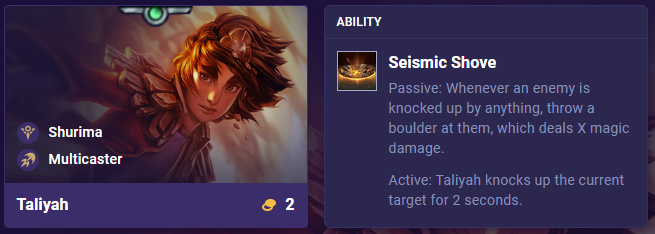
Taliyah is the only 2-cost Shurima unit, and she will complete the early game trio alongside Renekton and Cassiopeia. At level 4, you’ll likely want to put in another Bruiser to complete your frontline. Then, at level 5, Teemo will be your best addition to make your strongest board.
Teemo will synergize with Cassiopeia and her ability, while also giving Multicaster alongside Taliyah. Furthermore, in the mid-late game, once you find Jarvan or Azir, Teemo will also provide a level of Strategist to your board.
Akshan
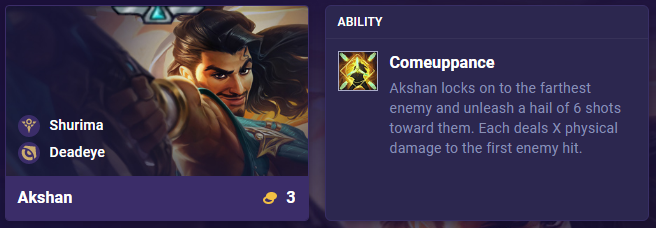
Akshan is the only 3-cost Shurima unit, and he’s somewhat the odd one out. Deadeye doesn’t really synergize well with the rest of the Shurima units, as they incentivize more AP comps.
However, in a vertical Shurima comp, Akshan is still a unit you can place extra AD items on, so that is something to keep in mind.
Azir

Azir is the 4-cost carry of the Shurima trait. His ability scales off AP and Attack Speed, so you’ll often see him with Guinsoo’s Rageblade along with other damage items like Giant Slayer, Jeweled Gauntlet, etc. Lastly, a healing item for a third item like Hextech Gunblade or Hand of Justice is usually seen as well.
As previously mentioned, Azir’s Strategist trait is a common build around with units like Jarvan, Teemo, or Swain. A Strategist Emblem from an Augment can also be very powerful as higher tiers become stronger and stronger.
Nasus
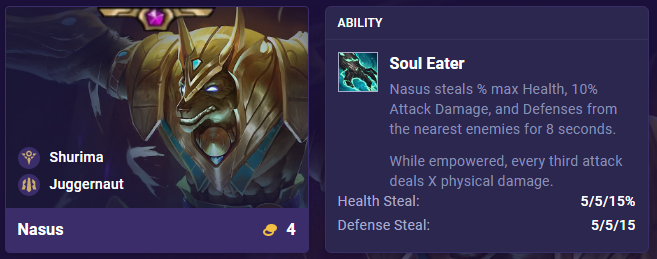
Nasus is the other 4-cost unit in the Shurima trait, and while his ability is quite strong, most people just look at him as a simple frontline unit. Juggernaut is a trait that makes him take less damage, so stacking additional defensive items on him can pay off very well.
So far, we haven’t seen too much innovation in terms of Nasus as a secondary carry, but that may change over time. As he stands, I would mainly consider him a frontline tank that’s also a good Thief’s Glove holder as he can use a large variety of items well.
K’Sante
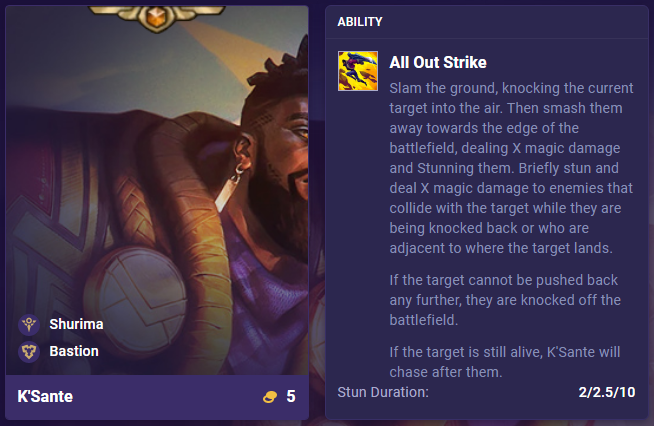
K’Sante is the last Shurima unit, and his ability is a long one. Simply put, he knocks his target away, and knocks up a bunch of enemies that collide with the impact. If his target is on the edge of the board, K’Sante will kick them off the map.
This ability is extremely powerful at removing powerful tanks off the board. The issue is if K’Sante can stay alive long enough to execute an enemy. If he can fully cast his ability, he can get off some valuable CC, but even K’Sante 1-star can be underwhelming.
In a vertical Shurima comp, he can be a bit tankier if he ascends, but as a stand alone 5-cost unit, he’s not usually preferred over units like Sion or Heimerdinger.
Best Shurima Augments
Here is a quick list of some of the standout Augments for the Shurima trait.
Shurima Heart / Crest / Crown
Every single trait benefits from having +1, and Shurima is no exception. Vertical Shurima comps haven’t really become meta in this first patch, but that may change with time.
Either way, playing vertical Shurima without +1 can be very dicey. You’re forced to run low cost units like Cassiopeia and Renekton if you want to hit Shurima 7, and you also have to find K’Sante. Both of these factors make it so Shurima 7 is ideally played with an Emblem or +1.
Shurima’s Legacy
Once assembled, your Sun Disc attacks enemies for 150-750 Magic Damage every 2 seconds (based on current Stage). Gain 3 Shurimans.
As far as I know, the phrase “once assembled” refers to after your Shurimans ascend. This Augment provides a combat buff to your board, which is always a warm welcome. I am unsure if the Augment will proc instantly if you have Shurima 7, but maybe it does.
Overall, this Augment is decent if you’re already committed to Shurima, or have good items for Shurima and want to commit at 2-1.
Idealism
Gain a Hand of Justice. Champions with a Hand of Justice deal 18% increased damage.
Idealism is another strong Augment for Shurima as Azir does quite well with Hand of Justice. Furthermore, if you don’t play vertical, and instead play Demacia/Shurima, you can put a second Hand of Justice on Lux for dual carry potential.
Jeweled Lotus (Legend)
Your units’ Abilities can critically strike. Your units gain 15% Critical Strike chance.
Jeweled Lotus in general is a decent augment for any AP comp, but it’s a bit weaker than other Augment options. Even still, if there’s nothing better for your comp, Jeweled Lotus can be solid.
Shurima Team Comps
With everything in mind, let’s go over a few sample team comps for the Shurima trait. Keep in mind that these team comps aren’t meant to reflect the meta. These are simply different paths you can go down when approaching the Shurima trait.
As different patches come and go, different variations will be better than others, or the trait as a whole might be underpowered. If you want to see meta team comps, be sure to check out our Tier List.
Shurima 7 Team Comp
This first comp is what you expect from a vertical Shurima comp. Jarvan is the best holder for the Shurima Emblem, as he’s just a bit more important than Shen.
All things considered, the comp can do quite well, but depending on a Shurima +1 can get dicey. Without an Emblem or +1, you’ll have to drop Shen for Akshan. Akshan can be okay if you have tons of extra AD items, but it’s still not great. Shen also provides Invoker, which is a nice mana generation buff for the entire team.
Azir Lux Team Comp
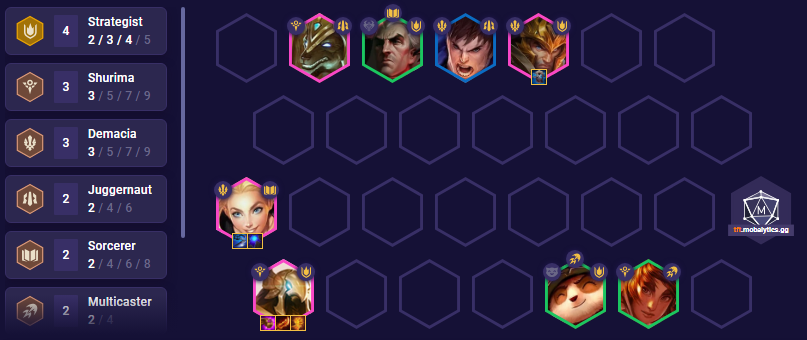
This second comp is a Shurima Strategist Demacia comp. Instead of going vertical into Shurima, we spread out a lot of traits and run dual AP carries. 4 Strategist provides a lot of extra strength to the team, and Demacia also provides a Radiant item for Lux or Jarvan.
Furthermore, there is a synergy between Lux and Azir. Lux’s ability will lower the MR of her target. Thus, if you place Lux and Azir close together, they will blow up enemy frontlines faster than by themselves. The downside to this comp is that your frontline can be lacking if you don’t have enough items for them, but the damage is there.
Conclusion
Overall, Shurima is a solid trait that focuses mainly on AP focused comps. This is due to Azir being the flagship carry for Shurima, and other units also synergizing with AP comps.
While vertical Shurima hasn’t made waves yet, you’ll often see Shurima (3) in combination with Demacia or Noxus comps. I didn’t cover the Noxus/Shurima comp in this article, but you can find it in my Noxus Guide.
As patches come and go, we may see more innovations being made, like Akshan carry, or maybe even Renekton carry. But for now, this is my rundown of how to play Shurima.
We hope you enjoyed this guide, and hopefully it helps you climb some ranks. Good luck and have fun!
Thanks for reading! Be sure to check out our meta team comps page, or head to our Team Builder to try and come up with your own comps.
Subscribe to our newsletter:
Don’t miss out on all of the latest TFT content!
 Download APP
Download APP Collapse
Collapse

